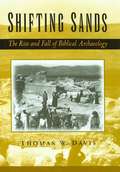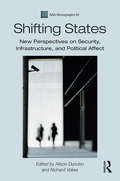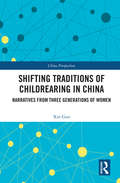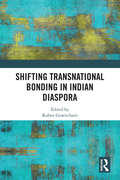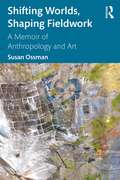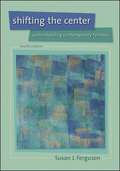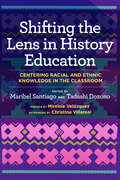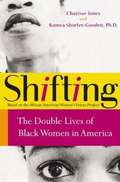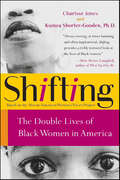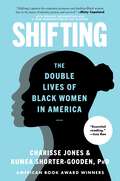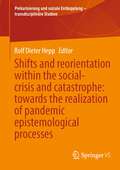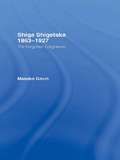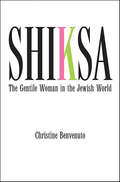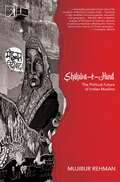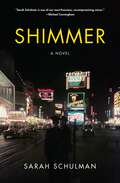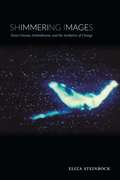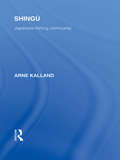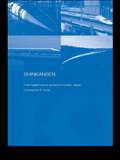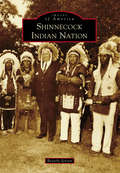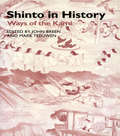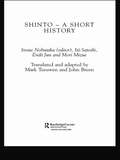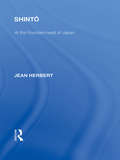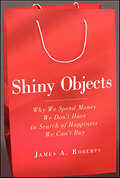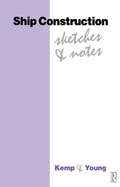- Table View
- List View
Shifting Sands: The Rise and Fall of Biblical Archaeology
by Thomas W. DavisIn Shifting Sands, Thomas W. Davis charts the evolution and the demise of the discipline. Davis traces the fascinating story of the interaction of biblical studies, theology, and archaeology in Palestine, and the remarkable individuals who pioneered the discipline. He highlights the achievements of biblical archaeologists in the field, who gathered an immense body of data.
Shifting States: New Perspectives on Security, Infrastructure, and Political Affect (ASA Monographs)
by Alison DundonShifting States draws on a rich history of anthropological theorising on all kinds of states – from the pre- to the post- industrial – and explores topics as diverse as bureaucracy, infrastructure, surveillance, securitization, and public health. As we enter the third decade of the twentieth century, there is a growing sense that ‘the state’ is in crisis everywhere. Although the nature of this perceived crisis varies from place to place, everywhere it is seen to have been caused by some combination of the inter-related forces of ‘globalisation’, of successive economic shocks, and of the rise of social media-fuelled populist movements. Yet, conversely, there is also a creeping perception that state power is becoming more pervasive in its reach, and in its effects, in ways which make it ever more imminent to the material worlds in which we live, more fundamental to the ways in which we conceive of the future, and more foundational to our very sense of self. How might we try to make sense of, and to mediate, these apparently contradictory impressions? Based on ethnographic case studies from all over the world, this timely volume forges new ways of thinking about how state power manifests, and is imagined, and about the effects it has on ordinary people’s lives. In so doing, the volume provides tools not only for understanding states’ responses to the COVID-19 pandemic, but also for judging what effects these responses are likely to have.
Shifting Traditions of Childrearing in China: Narratives from Three Generations of Women (China Perspectives)
by Xin GuoUnique in its intergenerational approach to understanding motherhood in China, this book sets out to study Chinese mothers’ experiences of childrearing, emphasising that gender is not immutable and that motherhood is not isolated from other social domains. The author adopts an historical and sociological design with a case study approach to investigate three living generations of women from 12 families of varied social-economic backgrounds in China. By comparing three aspects of these mothers’ lives – namely the growing-up experiences, mothering experiences and intergenerational transmission between mothers and daughters – this research provides an invaluable opportunity to ‘observe’ how changing structural elements shaped mothers’ varied subjectivities similarly or differently. It also addresses the continuities of the women’s experiences, highlighting the gendered and devalued roles in childcare that existed across three generations, reflecting the complex dynamic relationship between women’s agency and China’s social structures. This is an essential read for researchers, students, professionals and practitioners in the fields of sociology of families, childhood and education, gender studies, motherhood/parenthood studies, narrative studies, social policy and development studies.
Shifting Transnational Bonding in Indian Diaspora
by Ruben GowricharnThis volume examines Indian diasporic communities in various countries including the United Kingdom, Trinidad, Portugal, Netherlands, and Fiji, among others, and presents new perspectives on the shifting nature of Indian transnationalism. The book: Discusses how migrant communities reinforce the diaspora and retain a group identity, while at the same time maintaining a bond with their homelands; Highlights new tendencies in the configuration of Indian transnationalism, especially cultural entanglements with the host countries and the differentiation of homelands; Studies forces affecting bonding among these communities such as global and local encounters, glocalisation, as well as economic, political, and cultural changes within the Indian state and the wider Indian diaspora. Featuring a diverse collection of essays rooted in robust fieldwork, this volume will be of great importance for students and researchers of diaspora studies, globalization and transnational migration, cultural studies, minority studies, sociology, political studies, international relations, and South Asian studies.
Shifting Worlds, Shaping Fieldwork: A Memoir of Anthropology and Art
by Susan OssmanReflecting on fieldwork for the twenty-first century, anthropologist and artist Susan Ossman invites readers on a journey across North Africa, Europe, the Middle East, and North America. She reveals that fieldwork today is not only about being immersed in a place or culture; instead, it is an active way of focusing attention and engendering encounters and experiences. She conceives a new kind of autoethnography, making art and ethnography equal partners to follow three "waves" of her research on media, globalization, and migration. Ossman guides the reader through diverse settings, including a colonial villa in Casablanca, a Cairo beauty salon, a California mall-turned-gallery, the Berlin Wall, and Amsterdam’s Hermitage museum. She delves into the entanglements of solitary research and collective action. This book is a primer for current anthropology and an invitation to artists and scholars to work across boundaries. It vividly shows how fieldwork can shape scenes for experiments with multiple outcomes, from conceptual advances to artworks, performances to dialogue and community making.
Shifting the Center: Understanding Contemporary Families (Fourth Edition)
by Susan J FergusonThis anthology explores the issues and diversity of contemporary families, presenting balanced coverage of racial and ethnic variation and discussing a wide variety of family arrangements and processes. 32 out of the 50 selections included are new to this edition.
Shifting the Lens in History Education: Centering Racial and Ethnic Knowledge in the Classroom
by Tadashi Dozono Maribel SantiagoA persuasive collection that considers how centering the knowledge and perspectives of historically marginalized groups enriches K-12 history teaching and learning
Shifting: The Double Lives of Black Women in America
by Charisse Jones Kumea Shorter-GoodenInscription from the author: The Users of Bookshare.org-- May you find ways to fulfill your dreams and to help create a better world---Kumea Shorter-Gooden Shifting A RESOURCE FOR WOMEN THAT Finally gives a name to the behavioral changes and emotional ups and downs that Black women undergo in the face of bias Shows how age-old myths and stereotypes continue to affect Black women today Breaks down the coping mechanisms Black women utilize to deal with discrimination, such as "walling it off" and fighting back Candidly talks about the "home codes" Black women must follow within their own community, such as speaking a certain way or behaving submissively in church or with their partners Pointedly discusses how undervalued and overlooked many Black women feel in the workplace Shows the connection between dealing with bias and the disproportionately high rates of hypertension, obesity, and depressive symptoms among Black women Sheds light on the "Sisterella complex," a distinct manifestation of depression common among Black women Explores the "lily complex," the pressure Black women feel to reflect a White beauty ideal Provides answers and offers examples of how women can reconnect with their true selves by seeking professional counseling, starting their own businesses, joining support groups, or taking other proactive steps WHAT SETS THIS BOOK APART Based on the African American Women's Voices Project, this is one of the most comprehensive studies ever conducted of Black women's experiences with bias Engages all people, regardless of gender or ethnicity, with its poignant stories and common themes Unlike most books in the marketplace, Shifting explores the impact of both racial and gender bias on Black women Written in an accessible style; the dozens of women interviewed tell their personal stories in their own voices. Their honesty reminds readers that they are not the only ones dealing with certain challenges Weaves together the existing research on the impact of bias on Black women while also building upon it with original findings Gives a window into the experiences of 19 million Americans Shines a light on the persistence of bias and discrimination in the twenty-first century and provides insights for all Americans on how we might build a fairer and more just society
Shifting: The Double Lives of Black Women in America
by Charisse Jones Kumea Shorter-GoodenCommemorating its 2oth year in print with a new Introduction and updated content, Shifting explores the many identities Black women must adopt in various spaces to succeed in America. Based on the African American Women's Voices Project, Shifting reveals that a large number of Black women feel pressure to compromise their true selves as they navigate America's racial and gender bigotry. Black women "shift" by altering the expectations they have for themselves or their outer appearance. They modify their speech. They shift "white" as they head to work in the morning and "Black" as they come back home each night. They shift inward, internalizing the searing pain of the negative stereotypes that they encounter daily. And sometimes they shift by fighting back. In commemoration of its twentieth year in print with a new Introduction and updated content throughout Shifting is a much-needed, clear, and comprehensive portrait of the reality of Black women's lives today.
Shifting: The Double Lives of Black Women in America
by Kumea Shorter-Gooden Ms. Charisse JonesCommemorating its 20th year in print with a new Introduction and updated content, Shifting explores the many identities Black women must adopt in various spaces to succeed in America. Based on the African American Women's Voices Project, Shifting reveals that a large number of Black women feel pressure to compromise their true selves as they navigate America's racial and gender bigotry. Black women "shift" by altering the expectations they have for themselves or their outer appearance. They modify their speech. They shift "white" as they head to work in the morning and "Black" as they come back home each night. They shift inward, internalizing the searing pain of the negative stereotypes that they encounter daily. And sometimes they shift by fighting back. In commemoration of its twentieth year in print with a new Introduction and updated content throughout Shifting is a much-needed, clear, and comprehensive portrait of the reality of Black women's lives today.
Shifts and reorientation within the social-crisis and catastrophe: towards the realization of pandemic epistemological processes (Prekarisierung und soziale Entkopplung – transdisziplinäre Studien)
by Rolf Dieter HeppIn the pandemic, the state in Germany reacts in lockdown with restrictions within the private sphere of a shutdown of the leisure and cultural sphere, while the work contexts are only peripherally affected. Out of this crisis, new techniques of leadership are intensifying. Discipline and norms are no longer suitable enough to ensure productivity in today's world, which is why there is a shift towards self-directed processes and mechanisms such as flexibility, motivation and goal setting. The actors are therefore no longer assigned a fixed place in the sense of discipline, but are encouraged to surrender to the new control mechanisms and to adapt themselves again and again with a high degree of self-control. The realistic fear of contagion reinforces the actors' willingness to submit to these forms of mobilization.
Shiga Shigetaka 1863-1927: The Forgotten Enlightener
by Masako GavinShiga Shigetaka was a pioneering advocate of the preservation of Japan's cultural identity in the face of increasing pressure from the west. This book presents a realistic picture of Shiga's beliefs and thus gain insight into modern Japanese intellectual history.
Shiksa: The Gentile Woman in the Jewish World
by Christine BenvenutoShe is feared and desired. She is the symbol of a family's failure and a culture's dissolution. She is a courageous ally, a loyal fellow traveler, and a mother struggling for the survival of the same family and culture whose destruction she supposedly seeks.The gentile woman has been all these things and more to the Jewish people. Her almost mythic status has its roots in the dawn of Jewish history and repercussions that extend beyond our own time to shape the Jewish future. It also entails more baggage than any woman could possibly hope to carry. Shiksa: The Gentile Woman in the Jewish World, unpacks that baggage. Shiksa tells the stories of gentile women and women converts living in the Jewish community today, sharing insights from rabbis, Jewish feminists, educators and therapists. The book explores relationships between Jewish and gentile women, particularly Jewish mothers and their gentile daughters-in-law, as well as those between Jewish men and gentile women. And it looks at some of the fascinating Biblical figures whose stories startle with their relevance to today's most intimate issues of Jewish identity. At a time when the Jewish community is rife with concern over intermarriage, Shiksa offers a fearless examination of the gentile and converted women residing within its gates, occupying embattled yet permanent places as partners, daughters, sisters, mothers, friends.
Shikwa-e-Hind: The Political Future of Indian Muslims
by Dr Mujibur RehmanRoughly 200 million today, Indian Muslims are greater than the population of Britain and France or Germany put together. According to the Indian Constitution, Indian Muslims are treated as political equals, which is what India&’s secular polity promised after its independence, encouraging more than 35 million Indian Muslims at the time of Partition to choose India as their motherland over Pakistan. However, the supposed relationship of equality between Hindus and Muslims as scripted in the constitution is being increasingly replaced by the domineering tendencies of a Hindu majority in India today. The author describes the current state and position of Indian Muslims (the seeds for which were sown when the BJP came to power in 2014) as the thirdpolitical moment; the second he believes was in 1947 when the community was given equal status in the Indian Constitution; and the first, was in 1857 when Indian Muslims learnt to live under the British colonial state. As he states, there is no denying that political circumstances for Indian Muslims were not completely ideal or full of democratic energy prior to the rise of the Hindu Right since the late 1980s. With numerous layers defined by language, ethnicity, region, etc., Muslims have the most heterogeneous identity, representing India&’s quintessential diversity. And yet, Muslims are perceived as the most enduring well-grounded threat to the majoritarian project of the Hindu Rashtra. Indian Muslims are perceived or presented as perpetrators of violence and violators of law, even if they are at the receiving end. They are viewed as an internal enemy, who need to be dealt with for political, social, historical, and ideological reasons. Going forward, the community must formulate the language of democratic rights of Indian Muslims as equal citizens and define the ethics of human dignity in their struggle to reassert their place in India&’s political power structures at all levels: from panchayat to Parliament. While the economic future or cultural rights of Indian Muslims have been debated since 1947, it is the political future that demands attention because only as an equal and participatory community in the politics of the nation, can economic and cultural futures be addressed. This book explores the political future of Indian Muslims in this context. From Shaheen Bagh to Hindu-Muslim riots, from the unique position of Muslim women in India to the Sachar Report and the Muslim backwardness debate, Mujibur Rehman analyses, confronts and discusses the urgent concerns of Indian Muslims in a manner that is nuanced and globally relevant.
Shimmer
by Sarah SchulmanA revelatory portrait of McCarthy-era Manhattan—back in print!It is 1948 in Manhattan. Aspiring reporter Sylvia Golubowsky pays her dues in the steno pool at the tabloid New York Star, along with sixteen other girls whose eyes are on the back of the chair in front of them, the next step up the ladder. At the rival paper across town, gossip columnist Austin Van Cleeve rules New York and Washington with his venomous pen. In the Village, Columbia University graduate Cal Byfield is stuck flipping burgers to support his dream of a Negro theater on Broadway.Against the backdrop of post–World War II New York City and under the growing shadow of the Red Scare, these three indelible characters collide with one another amidst the larger drama of the historical moment. In a fresh re-interpretation of the McCarthy era, Sarah Schulman reframes our understanding of the “blacklist” to show how racial and sexual discrimination create their own ongoing exclusions and how the politics of treachery affect the most intimate relationships.First published in 1998, Shimmer draws parallels between the McCarthy era and contemporary American life and upends the tropes of film noir, pulp fiction, and set pieces of midcentury America by positioning a Black man and a queer Jewish woman as emblematic Americans. In a story set before the advent of the collective revolutionary movements of the 1960s, Cal and Sylvia learn the hard way that the American Dream was not available to them.This new edition of Shimmer includes a postscript by the author.
Shimmering Images: Trans Cinema, Embodiment, and the Aesthetics of Change
by Eliza SteinbockIn Shimmering Images Eliza Steinbock traces how cinema offers alternative ways to understand gender transitions through a specific aesthetics of change. Drawing on Barthes's idea of the “shimmer” and Foucault's notion of sex as a mirage, the author shows how sex and gender can appear mirage-like on film, an effect they label shimmering. Steinbock applies the concept of shimmering—which delineates change in its emergent form as well as the qualities of transforming bodies, images, and affects—to analyses of films that span time and genre. These include examinations of the fantastic and phantasmagorical shimmerings of sex change in Georges Méliès's nineteenth-century trick films and Lili Elbe's 1931 autobiographical writings and photomontage in Man into Woman. Steinbock also explores more recent documentaries, science fiction, and pornographic and experimental films. Presenting a cinematic philosophy of transgender embodiment that demonstrates how shimmering images mediate transitioning, Steinbock not only offers a corrective to the gender binary orientation of feminist film theory; they open up new means to understand trans ontologies and epistemologies as emergent, affective, and processual.
Shingu: A Study of a Japanese Fishing Community (Routledge Library Editions: Japan)
by Arne KallandFrom being an important centre which attracted a large number of merchants during the feudal period, Shingū, on the northern shores of Kyushu is today a suburb of Fukuoka City. Fishing is a slowly-dying occupation and this volume analyses how the fishermen adjust to changing circumstances. Although Japan is the largest fishing nation in the world, when originally published this book was the first to be published in English which focussed on the composition and role performance of the crews and larger net-groups. This analysis has been set in an historical perspective, showing how the vertical structures during the Tokugawa period have changed to more egalitarian structures where much energy is spent to hinder the development of any new hierarchy.
Shingwauk's Vision
by J. R. MillerWith the growing strength of minority voices in recent decades has come much impassioned discussion of residential schools, the institutions where attendance by Native children was compulsory as recently as the 1960s. Former students have come forward in increasing numbers to describe the psychological and physical abuse they suffered in these schools, and many view the system as an experiment in cultural genocide. In this first comprehensive history of these institutions, J.R. Miller explores the motives of all three agents in the story. He looks at the separate experiences and agendas of the government officials who authorized the schools, the missionaries who taught in them, and the students who attended them.Starting with the foundations of residential schooling in seventeenth-century New France, Miller traces the modern version of the institution that was created in the 1880s, and, finally, describes the phasing-out of the schools in the 1960s. He looks at instruction, work and recreation, care and abuse, and the growing resistance to the system on the part of students and their families. Based on extensive interviews as well as archival research, Miller's history is particularly rich in Native accounts of the school system.This book is an absolute first in its comprehensive treatment of this subject. J.R. Miller has written a new chapter in the history of relations between indigenous and immigrant peoples in Canada.Co-winner of the 1996 Saskatchewan Book Award for nonfiction.Winner of the 1996 John Wesley Dafoe Foundation competition for Distinguished Writing by CanadiansNamed an 'Outstanding Book on the subject of human rights in North America' by the Gustavus Myer Center for the Study of Human Rights in North America.
Shinkansen: From Bullet Train to Symbol of Modern Japan (Routledge Contemporary Japan Series)
by Christopher HoodThe image of the shinkansen – or ‘bullet train’ – passing Mount Fuji is one of the most renowned images of modern Japan. Yet, despite its international reputation for speed and punctuality, little is understood about what makes it work so well and what its impact is. This is a comprehensive account of the history of the shinkansen, from its planning during the Pacific War, to its launch in 1964 and subsequent development. It goes on to analyze the reasons behind the bullet train’s success, and demonstrates how it went from being simply a high-speed rail network to attaining the status of iconic national symbol. It considers the shinkansen’s relationship with national and regional politics and economic development, its financial viability, the environmental challenges it must cope with, and the ways in which it reflects and influences important aspects of Japanese society. It concludes by considering whether the bullet train can be successful in other countries developing high-speed railways. Overall, this book provides a thorough examination of the phenomenon of the shinkansen, and its relationship with Japanese society.
Shinnecock Indian Nation (Images of America)
by Beverly JensenThe Shinnecock have resided along the shores of eastern Long Island for more than 10,000 years. These hunter-gatherers were also skilled whalers who first tackled the Atlantic in their dugout canoes and later became highly regarded crew members on 19th-century whaling ships that sailed the globe. The Shinnecock were also noted wampum makers, using the northern quahog hard-shelled clam and whelk shells to craft some of the finest-quality wampum beads to be found anywhere along the eastern seaboard. Since the first tall ships sailed into the local waters in the 1500s, new settlers and shifty land deals have diminished the ancestral territory of the Shinnecock Indian Nation. Despite overwhelming odds, however, and in the midst of immense privilege and wealth of their Hamptons neighbors, the Shinnecock remain. They are a federally recognized tribe with more than 1,500 enrolled members and are governed by a seven-member council of trustees.
Shinto in History: Ways of the Kami (Routledge Studies in Asian Religion)
by Mark Teeuwen John BreenThis is the only book to date offering a critical overview of Shinto from early times to the modern era, and evaluating Shinto's place in Japanese religious culture. In recent years, a few books on medieval Shinto have appeared, but none has attempted to depict the broader picture, to examine critically Shinto's origins and its subsequent development through the medieval, pre-modern and modern periods. The essays in this book address such key topics as Shinto and Daoism in early Japan, Shinto and the natural environment, Shinto and state ritual in early Japan, Shinto and Buddhism in medieval Japan, and Shinto and the state in the modern period. All of the essays highlight the dynamic nature of Shinto and shrine history by focusing on the three-way relationship, often fraught, between local shrine cults, Shinto agendas and Buddhism.
Shinto: A Short History
by Mark Teeuwen John BreenShinto - A Short History provides an introductory outline of the historical development of Shinto from the ancient period of Japanese history until the present day. Shinto does not offer a readily identifiable set of teachings, rituals or beliefs; individual shrines and kami deities have led their own lives, not within the confines of a narrowly defined Shinto, but rather as participants in a religious field that included Buddhist, Taoist, Confucian and folk elements. Thus, this book approaches Shinto as a series of historical 'religious systems' rather than attempting to identify a timeless 'Shinto essence'.This history focuses on three aspects of Shinto practice: the people involved in shrine worship, the institutional networks that ensured continuity, and teachings and rituals. By following the interplay between these aspects in different periods, a pattern of continuity and discontinuity is revealed that challenges received understandings of the history of Shinto.This book does not presuppose prior knowledge of Japanese religion, and is easily accessible for those new to the subject.
Shinto: At the Fountainhead of Japan (Routledge Library Editions: Japan)
by Jean HerbertShinto, the national indigenous religion of Japan has supplied Japan with the basic structure of its mentality and behaviour. Although its classical texts have been translated into English this volume was the first major study of this important religion. The book is a complete picture of Shinto, its history and internal organization, its gods and mythology, its temples and priests, its moral and worship. The volume also describes the metaphysics, mystic and spiritual disciplines and overall is one of the most authentic and authoritative surveys of Shinto of the twentieth century.
Shiny Objects: Why We Spend Money We Don't Have in Search of Happiness We Can't Buy
by James A. RobertsIn Shiny Objects, a cross between In Praise of Slowness and The Tipping Point, consumer behavior expert Professor James A. Roberts takes us on a tour of America's obsession with consumerism—pointing out its symptoms, diagnosing specific problems, and offering a series of groundbreaking solutions.Roberts gives practical advice for how to correct the materialistic trends in our lives which lock us into a cycle of financial hardship and stress. Shiny Objects, a new The Paradox of Choice for the modern reader, is more than a critique of capitalism—it's also an exploration into how we can live happier, fuller, more productive lives today.
Ship Construction Sketches and Notes
by Peter Young John F KempThis classic book in the Kemp and Young series has been fully revised and updated by David J Eyres, author of the well-known Butterworth-Heinemann title "Ship Construction," and will prove indispensable to the student reader. The contents cover, in numerous fully illustrated items, shipyard practices, principles of construction methods, the design and construction of the various component parts of the ship, and the overall arrangement of different types of merchant and passenger vessels.
